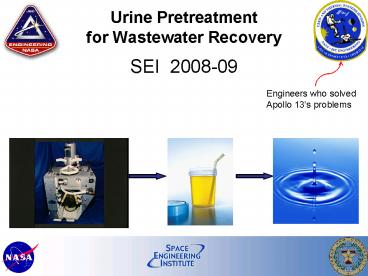Urine Pretreatment for Wastewater Recovery - PowerPoint PPT Presentation
1 / 25
Title:
Urine Pretreatment for Wastewater Recovery
Description:
The current pretreatment method utilizes a toxic chemical with little known ... Acetic Acid. Glycolic Acid. Sodium Permangante. Phosphoric Acid ... – PowerPoint PPT presentation
Number of Views:215
Avg rating:3.0/5.0
Title: Urine Pretreatment for Wastewater Recovery
1
Urine Pretreatmentfor Wastewater Recovery
- SEI 2008-09
Engineers who solved Apollo 13s problems
2
Overview
- Background
- Objectives
- Laboratory Tests
- Distillation Simulation
- Results Summary
- Team Accomplishments
- Future Tasks
- Acknowledgements
3
Team Structure
4
Water Use and Recovery
Water currently resupplied via shuttle Not
economical or practical to re-supply water for
long term missions
5
ISS wastewater sources
Distribution
Consumption
Hygiene
Perspiration
Exhalation
Humidity Condensate
Hygiene Waste
Urination
Urine pretreatment protects hardware and plumbing
system form clogging
- Solids precipitation
- Biofilm formation
6
Current Urine Pretreatment
String of Pearls
Not compatible with reclamation system
Urine and Fecal collection Unit
7
Problem Statement
The current pretreatment method utilizes a toxic
chemical with little known toxicological
information that may be detrimental to astronaut
health over time.
8
Previous work
- Supernatant Characterization from urine MAP
precipitation
- Chemical urine pretreatment
- Sulfuric Acid
- Sodium Benzoate
- Acetic Acid
- Glycolic Acid
- Sodium Permangante
- Phosphoric Acid
- TOC gt EPA drinking water limit
- Organics and Inorganics removal is needed
- High pH buffer
- Need to optimize precipitation reaction
Work presented in the 11th International
Conference on Engineering, Science, Construction,
and Operations in Challenging Environments (Earth
Space Conference)
9
Cascade Distillation Subsystemcurrently used for
water reclamation
- Centrifugal vacuum distillation
10
Project Objective
Identify a non-toxic pretreatment alternative
that is compatible with a distillation based
water reclamation system.
11
Project Tasks
- Task 1- Laboratory tests
- Select pretreatment chemicals
- Toxicity data, HMIS, pKa, Volatility
- Test chemicals pretreatment ability
- Task 2- Distillation simulation (Aspen)
- Research Cascade Distillation Subsystem
- Determine simulation operation conditions
- Simulate chemicals tested in Task 1
12
Task 1-Laboratory Test
Objective Compare pretreatment chemicals to
sulfuric acid in stored urine (1g/L)
- Chemical pH
- Physical TSS, Turbidity
- Biological Protein, Ammonia, DO
13
Chemicals Selected
- 1 g/L as active ingredient
- Chosen based on solubilty, pKa, and toxicity
- Delivery system for solid chemicals depends on
solubility
14
Experimental Methods
Urine collected
Urine collection carboy
Samples are taken at predetermined times
15
Analytical Methods
pH
TSS
Dissolved Oxygen
Turbidity
Ammonia Phenate Method
Protein Assay
16
Chemical Test Results
17
Physical Tests Results
18
Biological Tests Results
19
Biological Tests Results
20
Task 2- Simulation
- Objectives
- Determine water recovery at proposed operating
conditions - Determine acid recovery at proposed operating
conditions
21
Simulation Conditions
One stage flash (worst case scenario)
22
Simulation results
- Sulfuric, fumaric, and boric are separable from
water in the flash operating range of 25-50C - Currently unable to simulate sorbic acid
- Separation Efficiency
23
Results Summary
- Laboratory tests results
- Chemicals tested do meet pretreatment
requirements for short term storage - Chemicals tested do not meet pretreatment
requirements for long term storage - Distillation results
- Chemicals are separable from water in the flash
operating range of 25-50C. - Preliminary simulations indicate that high
chemical removal is possible
24
Future Tasks
- Laboratory tests
- Lactic acid
- Phthalic acids
- Simulation
- Separation efficiencies
- Lactic acid
- Phthalic acids
25
Acknowledgements
- Julianna Camacho
- Dr. Autenreith
- Dr. Pickering
- Magda Lagoudas
- Urine Video































